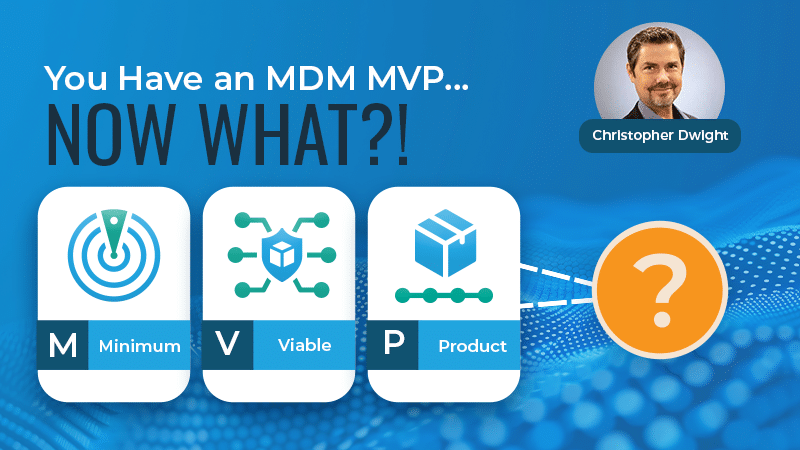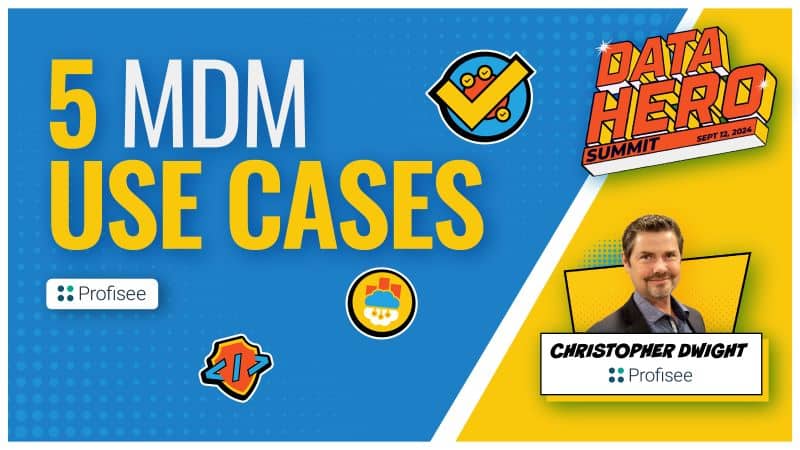Table of Contents
It is common knowledge that a boil-the-ocean approach is a surefire path to failure with any major initiative or program, and a master data management program is no different. For this reason, you most likely started your master data management (MDM) journey with a deliberately small scope. With an initial but limited success under your belt, it is time to assess and replan your journey to build upon your initial deployment and lessons learned to create iterative impacts to your business.
How do you move forward from here? In this article, I’ll go through seven seemingly straightforward but critically important steps to take with each successive iteration — gleaned from my conversations with real practitioners over my 20+ years in the MDM industry.
Done properly, each iteration will create additional business value and ensure that your master data management program is seen as a success by leadership and will enable you to become a data hero within your organization.
7 Critical Steps to Expanding Your MDM Implementation
Before leaping into the next iteration of your MDM program, it is critical to pause and seriously invest in each of the following steps:
1. Evaluate Current Success
Before diving into expansion, take a moment to assess the effectiveness of your initial MDM implementation. Understanding not only your current state but lessons learned from the initial implementation is crucial to inform your next iteration.
Here are some critical questions to ask about your current MDM implementation:
- Did your initial implementation meet the defined business outcomes identified at the outset? If not, what were the causes for not meeting the intended outcomes?
- Are you able to measure the impact of the initial implementation? Were affected business KPIs correctly identified up-front and correctly measured before and after the initial implementation? Can you quantify actual savings, revenue gains or risk reduction as a result of your initial implementation? If not, what are the barriers to quantifying outcomes?
- Did you have the correct level of executive and line-of-business sponsorship and engagement?
- Did you have the right project management, cadence and participation to ensure visibility and buy-in during the initial implementation? Were the right participants involved and engaged in weekly status and monthly steering committee meetings? Did line-of-business stakeholders remain engaged and involved from the implementation to delivery?
- Were data stewards identified, trained, and properly incentivized for their new stewardship tasks?
- Did you have the necessary skills and team members to make the initial implementation successful?
- Were the initial requirements correctly scoped and estimated? Were there changes in requirements and scope during the initial implementation? What was the root cause of any changes to scope, and how can that be prevented in future iterations? Was more time needed for design and planning? Were the right stakeholders properly engaged during design and planning?
- What were the challenges, barriers, or delays encountered? What were the root causes of those delays, and can the same challenges be avoided in future iterations?
2. “Outcome-First” Approach to Your Next Iteration
A common pitfall is to mistake a data domain (e.g., product, supplier, customer) as a use case, or a program KPI as a measure of data quality improvement. A use case is a specific application of MDM to enable or improve a core business function, such as customer onboarding, order-to-cash, procure-to-pay or enable advanced and reliable AI and analytics. A program KPI is a business metric, not a data metric, which will be clearly impacted by the improved master data.
Not all use cases are created equal. Just as you did with your initial MDM implementation, it is critical to prioritize your next expansion iteration based on alignment with business priorities and measurable impact on KPIs. This can be one of the most difficult parts of any MDM program. For example, to measure MDM’s impact on cross-sell and up-sell, you will need to identify and track cross-sell and up-sell targets identified through MDM as you would any other marketing / CRM campaign. Without clear and measurable KPIs impacted by your next iteration, you will be unable to demonstrate to your leadership the value of your ongoing MDM investment.
3. Define In-Scope Data Governance and Data Processes
Another common pitfall is to over-invest in data governance, or to overlook necessary changes to data processes and data flows. Although data governance is a critical part of any data management process improvement, governance alignment and documentation should be kept to in-scope data and data management processes.
It is an easy temptation to align and document governance policies and ownership on all critical data within the organization, instead of constraining the effort to in-scope data and data management processes. This can lead to a never-ending “science experiment” in governance that will deliver little value and potentially delay delivery of data improvements that have a tangible business impact.
In addition to aligning upon and defining data governance policies, it is also critical to understand, align upon and document changes to data flows and data processes. For example, if your next iteration involves customer data spanning your CRM and financial systems, you must align on and document the new customer data flows.
Prior to this iteration, customer data might originate in either the CRM or financial platforms, and changes to customer data might occur in both places. As part of this iteration, you will need to further your implementation style strategy by defining the new customer data flow (system of origination), and on an attribute-by-attribute basis, what system will be the system of record: CRM, finance, or now MDM.
Additionally, you will need to define the process and data flows for changes to customer data. What chances can happen where, and which of those changes will need to be synchronized across the affected systems?
4. Align People and Processes
As you plan for your next iteration, it is critical to understand the necessary supporting changes and investment in people and processes.
Have you identified and secured the right executive sponsorship for your next iteration? Will your next iteration require significant data stewardship? Do you have line-of-business buy-in and involvement in monthly steering committee meetings? Will your next iteration require integration to operational systems and do you have the correct skills and resource availability to develop the necessary integrations?
5. Iterate and Refine
As you navigate your next business use-case iteration, embrace an iterative and agile approach. Continuously gather feedback from end-users and stakeholders and be prepared to adjust your strategy and plan as needed.
Remember, MDM is a journey, not a one-time project. Each iteration brings opportunities for improvement and optimization, both within the iteration and with each new iteration.
6 Scale Responsibly
As you scale your MDM practice, be mindful of scalability challenges and resource constraints. Additionally, invest in training and development programs to empower your team to effectively manage and utilize master data in the expanded context.
7. Measure Impact
Finally, as you prepare to deploy your next MDM iteration, you must prepare for and continue to measure the impact of your expanded MDM solution.
This means benchmarking defined KPIs and then monitoring those KPIs for improvements as a result of your use-case deployment. Regularly assess and communicate to leadership the value delivered to the organization and use these insights to drive further improvements and optimizations and continue to secure executive sponsorship and buy-in to support the necessary changes to and investments in people and processes.
Remember: MDM is a Journey, Not a Destination
In conclusion, having successfully implemented an initial MDM strategy, you’re now poised to expand your use of master data management into additional use cases to deliver incremental business value.
By following a strategic approach, prioritizing business priorities, and embracing an iterative mindset, you can unlock even greater value from your MDM investment. Remember, the journey of MDM is ongoing, and each step forward brings new opportunities for growth and optimization.
Even after you have a live MDM implementation, it is critical to ‘sell’ your progress, goals and outcomes to business leadership to ensure organizational alignment and continued support. Read our complete guide to Selling MDM to Leadership for tips, best practices and insights that I’ve seen work for MDM practitioners.

Christopher Dwight
Christopher is a well-respected master data management (MDM) thought leader and the VP of MDM Strategic Programs at Profisee. Christopher has been in the enterprise information management and MDM space for more than 25 years, including senior leadership stints at Oracle and Informatica. Over those years, Christopher has engaged with hundreds of organizations to assist them in their data management strategies and MDM journeys.















